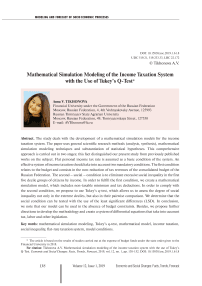Mathematical simulation modeling of the income taxation system with the use of Tukey's q-test
Автор: Tikhonova Anna V.
Журнал: Economic and Social Changes: Facts, Trends, Forecast @volnc-esc-en
Рубрика: Modeling and forecast of socio-economic processes
Статья в выпуске: 1 (61) т.12, 2019 года.
Бесплатный доступ
The study deals with the development of a mathematical simulation models for the income taxation system. The paper uses general scientific research methods (analysis, synthesis), mathematical simulation modeling techniques and substantiation of statistical hypotheses. This comprehensive approach is carried out in two stages; this fact distinguished our present study from previously published works on the subject. Flat personal income tax rate is assumed as a basic condition of the system. An effective system of income taxation should take into account two mandatory conditions. The first condition relates to the budget and consists in the non-reduction of tax revenues of the consolidated budget of the Russian Federation. The second - social - condition is to eliminate excessive social inequality in the first five decile groups of citizens by income. In order to fulfill the first condition, we create a mathematical simulation model, which includes non-taxable minimum and tax deductions...
Mathematical simulation modeling, tukey's q-test, mathematical model, income taxation, social inequality, flat-rate taxation system, model conditions
Короткий адрес: https://sciup.org/147224126
IDR: 147224126 | УДК: 519.21, | DOI: 10.15838/esc.2019.1.61.8
Список литературы Mathematical simulation modeling of the income taxation system with the use of Tukey's q-test
- Andreev M.Yu., Pospelov I.G., Pospelova I.I., Khokhlov M.A. Tekhnologiya modelirovaniya ekonomiki i model’ sovremennoi ekonomiki Rossii . Moscow: MIFI, 2007. 262 p.
- Gordon R.H., Kopczuk W. The choice of the personal income tax base. Journal of Public Economics, 2017, vol. 118, pp. 97-110.
- Lehmann E., Marical F., Rioux L. Labor income responds differently to income-tax and payroll-tax reforms. Journal of Public Economics, 2013, vol. 99, pp. 66-84.
- Long X., Pelloni A. Factor income taxation in a horizontal innovation model. Journal of Public Economics, 2017, vol. 154, pp. 137-159.
- Morini M., Pellegrino S. Personal income tax reforms: a genetic algorithm approach. European Journal of Operational Research, 2018, vol. 264, no. 3, pp. 994-1004.
- Kovárnik J., Hamplová E. Value tax equity and tax literacy as causality of tax incidence. International Journal of Economics and Statistics, 2013, vol. 1, no. 2, pp. 68-76.
- Hungerman D.M. Public goods, hidden income, and tax evasion: Some nonstandard results from the warm-glow model. Journal of Development Economics, 2014, vol. 109, pp. 188-202.
- Petrucci A. Optimal income taxation in models with endogenous fertility. Journal of Macroeconomics, 2015, vol. 43, pp. 216-225.
- Tran Ch. Temptation and taxation with elastic labor. Economic Modelling, 2018, vol. 70, pp. 351-369.
- Ching-Chong L., Chih-Hsing L. Optimal nonlinear income taxation with productive government expenditure. International Review of Economics & Finance, 2012, vol. 22 (1), pp. 66-77.
- Liskina E.Yu. Some mathematical models of taxes and dues in Russia. Vestnik Ryazanskogo gosudarstvennogo universiteta im. S.A. Esenina=Bulletin of Ryazan State University named for S.A.Yesenin, 2014, no. 2 (43), pp. 168-182..
- Smirnov R.O., Chistyakov S.V. Modeling the choice of the regressive scale of the unified social tax. Vestnik Sankt-Peterburgskogo universiteta. Ekonomika=St Petersburg University Journal of Economic Studies, 2003, no. 4 (29), pp. 79-85..
- Smirnov R.O. Modeling of choosing the parameters of the income tax schedule. Vestnik Sankt-Peterburgskogo universiteta. Ekonomika=St Petersburg University Journal of Economic Studies, 2011, no. 4, pp. 141-148..
- Bertotti M.L., Modanese G. Micro to macro models for income distribution in the absence and in the presence of tax evasion. Applied Mathematics and Computation, 2014, vol. 244, pp. 836-846.
- Sybiryanska Yu.V., Kondratenko M.B. The new model of the tax system of Ukraine: the redistribution of the tax burden. Biznes inform, 2014, no. 7, pp. 276-283.
- Mel’nikov Yu.B., Onokhina E.A., Shitikov S.A. Improving the adequacy of economic models. Izvestiya Ural’skogo gosudarstvennogo ekonomicheskogo universiteta=Journal of the Ural State University of Economics, 2018, vol. 19, no. 1, pp. 94-106..
- Mironov V.V., Smirnov A.V. On the problem of mathematical modeling of simulation models of socio-economic development of the region. Korporativnoe upravlenie i innovatsionnoe razvitie ekonomiki Severa: Vestnik Nauchno-issledovatel’skogo tsentra korporativnogo prava, upravleniya i venchurnogo investirovaniya Syktyvkarskogo gosudarstvennogo universiteta=Korporativnoe upravlenie i innovacionnoe razvitie economiki Severa, 2012, no. 3, p. 8..
- Allanson P. Income stratification and between-group inequality. Economics Letters, 2014, vol. 124, no. 2, pp. 227-230.
- Molero-Simarro R. Inequality in China revisited. The effect of functional distribution of income on urban top incomes, the urban-rural gap and the Gini index, 1978-2015. China Economic Review, 2017, vol. 42, pp. 101-117.
- Khosravi Tanak A., Mohtashami Borzadaran G.R., Ahmadi J. Entropy maximization under the constraints on the generalized Gini index and its application in modeling income distributions. Physica A: Statistical Mechanics and its Applications, 2015, vol. 438, pp. 657-666.
- Tikhonova A.V. Non-taxable minimum for individual income tax as a tool of socialization of the tax system of Russia. Nalogi=Taxes, 2018, no. 4, pp. 36-40..
- Kalinina O. Economic-mathematical models of progressive income taxation in Russia. International Journal of Economics and Statistics, 2015, vol. 3, pp. 39-47.


